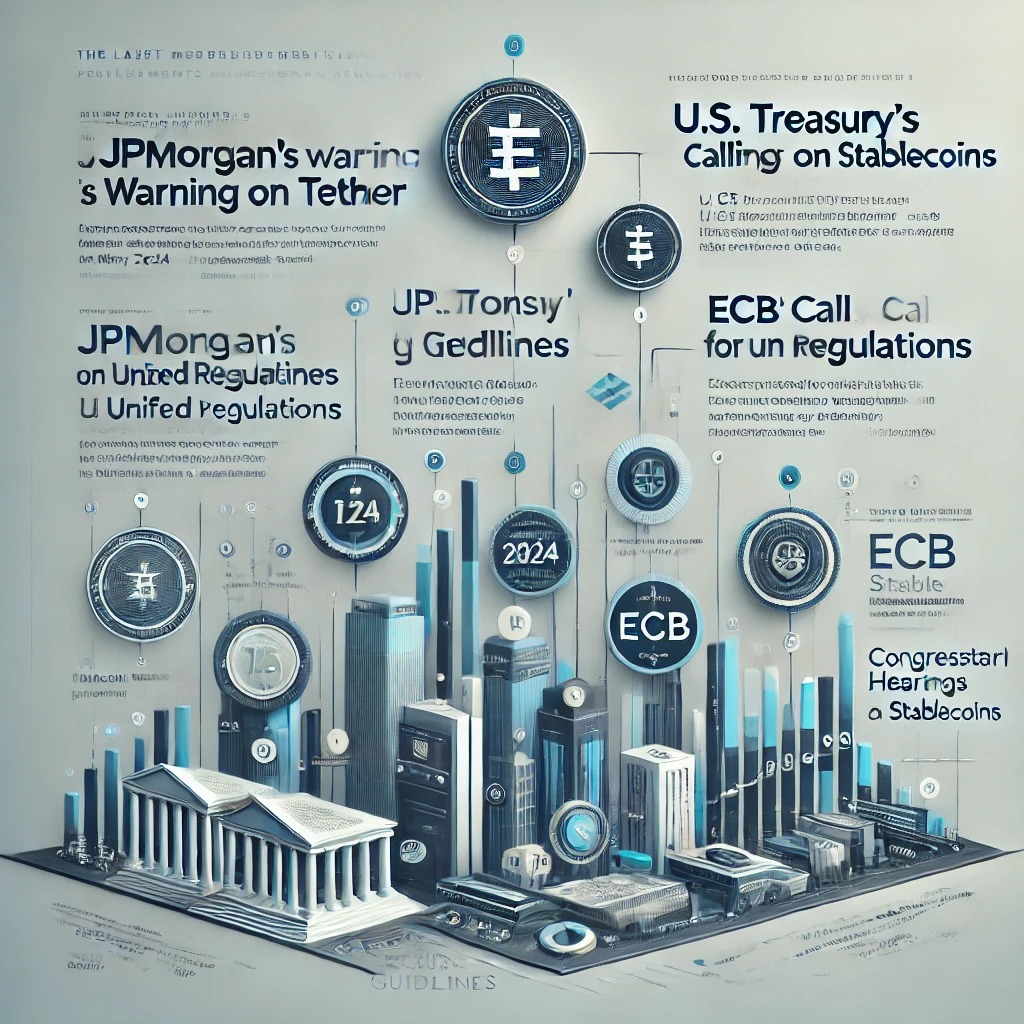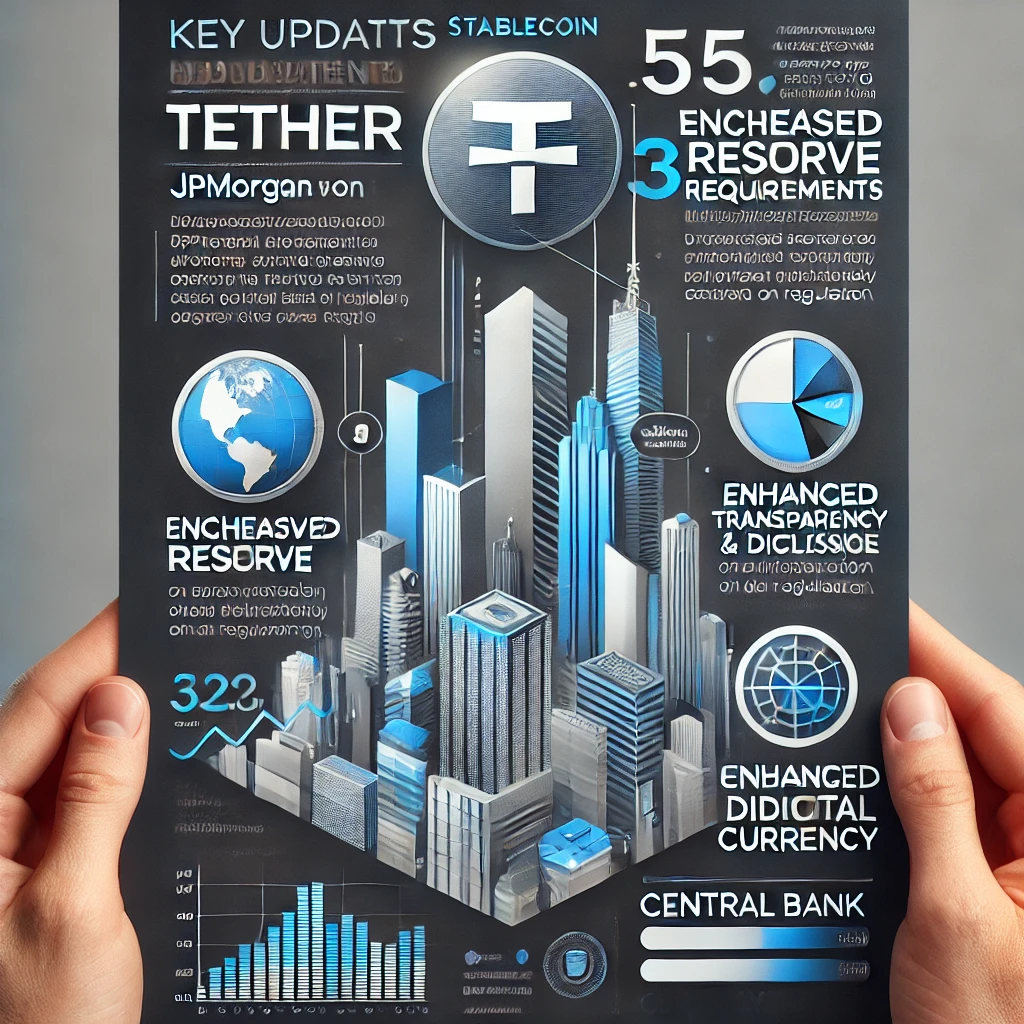Introduction to Stablecoin Regulations
As the cryptocurrency market continues to expand, the focus on stablecoin regulations has intensified. Stablecoins, digital assets pegged to the value of traditional currencies, are increasingly seen as a bridge between the volatile world of cryptocurrencies and the more stable financial system. However, the rise of stablecoins has also raised significant regulatory concerns. Recently, JPMorgan issued a warning that new stablecoin regulations could pose serious challenges for Tether, one of the most prominent stablecoins in the market. These regulatory changes could have far-reaching implications for the broader cryptocurrency ecosystem, especially as discussions around Central Bank Digital Currency (CBDC) also gain momentum. In this blog post, we will explore the key aspects of these new stablecoin regulations, their potential impact on Tether and other cryptocurrencies, and what the future holds for the stablecoin market.
What’s New in Stablecoin Regulations?
Stablecoin regulations are evolving rapidly as governments and financial institutions recognize the need to impose stricter controls on these digital assets. The primary concern is the lack of transparency and regulatory oversight in the stablecoin market, which could pose risks to financial stability. The recent focus on Tether by regulatory bodies underscores the urgency of establishing a clear regulatory framework for stablecoins, especially as global discussions around Central Bank Digital Currency (CBDC) begin to shape the future of money.

Latest Developments
| Date | Event | Impact |
|---|---|---|
| August 2024 | JPMorgan issues warning on potential risks for Tether under new regulations | Raises concerns about the stability and future of Tether, leading to market uncertainty |
| July 2024 | U.S. Treasury proposes new guidelines for stablecoin issuers | Pushes for increased transparency and reserve requirements |
| June 2024 | European Central Bank calls for unified stablecoin regulations across the EU | Aims to standardize regulations and reduce risks associated with stablecoin usage |
| May 2024 | Congressional hearings on the impact of stablecoins on the financial system | Highlights the need for a comprehensive regulatory approach to protect investors and the economy |
These developments indicate a growing consensus among global regulators on the need for a robust regulatory framework for stablecoins. The specific focus on Tether, given its significant market share, has brought these issues to the forefront, potentially signaling major changes in the cryptocurrency market. Additionally, the development of Central Bank Digital Currency (CBDC) could further complicate the regulatory landscape, as governments look to assert control over digital assets.
Key Updates You Need to Know
The landscape of stablecoin regulations is shifting, with several key updates that will significantly impact Tether and the broader cryptocurrency market. These changes aim to enhance transparency, ensure financial stability, and protect investors.

1. JPMorgan’s Warning on Tether
JPMorgan’s recent analysis highlights the potential risks that new stablecoin regulations could pose for Tether. As one of the largest stablecoins by market capitalization, Tether is particularly vulnerable to regulatory changes. JPMorgan warns that stricter reserve requirements and increased transparency demands could challenge Tether’s current operations, potentially leading to a reduction in its market dominance. This shift could also open the door for Central Bank Digital Currency (CBDC) initiatives, as governments look for more secure and regulated alternatives to cryptocurrency.
2. Increased Reserve Requirements
One of the most significant changes in the new regulations is the increased reserve requirements for stablecoins. Regulators are pushing for stablecoin issuers to hold a higher percentage of their reserves in liquid assets, such as cash or government bonds. This measure is intended to ensure that stablecoins can be fully backed and redeemed at any time, thereby reducing the risk of a run on the stablecoin. This regulatory push parallels efforts to promote Central Bank Digital Currency (CBDC) as a more controlled and secure digital asset.
3. Enhanced Transparency and Disclosure
Transparency is a major focus of the new stablecoin regulations. Issuers like Tether will be required to provide regular, detailed disclosures about their reserves, including the composition and liquidity of these assets. This move is designed to build trust with investors and ensure that stablecoins maintain their peg to traditional currencies. The emphasis on transparency is also seen in discussions around Central Bank Digital Currency (CBDC), where clear guidelines and disclosures are essential to gaining public trust.
4. Global Coordination on Regulation
Another critical development is the push for global coordination on stablecoin regulations. Regulatory bodies in the U.S., EU, and other major economies are increasingly working together to develop a unified regulatory framework. This global approach aims to prevent regulatory arbitrage, where stablecoin issuers might seek more lenient jurisdictions to operate, potentially undermining global financial stability. This coordinated effort is also relevant to the development of Central Bank Digital Currency (CBDC), as countries aim to harmonize their approaches to digital currencies.
What’s Next?

As the new stablecoin regulations begin to take shape, the cryptocurrency market is bracing for potential disruptions. Tether, given its size and influence, is likely to be one of the first stablecoins affected by these changes. If Tether fails to meet the new regulatory requirements, it could lead to a loss of confidence among investors, resulting in significant market volatility. This scenario could also accelerate the adoption of Central Bank Digital Currency (CBDC), as governments offer a regulated alternative to stablecoins.
Moreover, the broader impact of these regulations could extend to other stablecoins and the cryptocurrency market as a whole. Stablecoins have been a critical component of the crypto ecosystem, providing liquidity and stability. Stricter regulations could lead to a re-evaluation of the role of stablecoins, possibly paving the way for new, more compliant stablecoins to emerge. At the same time, the rise of Central Bank Digital Currency (CBDC) could reshape the digital currency landscape, offering a state-backed solution to the challenges posed by cryptocurrency.
In the coming months, we can expect to see further developments as regulators refine their approach to stablecoin oversight. The industry will need to adapt quickly to these changes, with stablecoin issuers like Tether possibly being required to overhaul their operations to comply with the new rules. The intersection of stablecoin regulations and Central Bank Digital Currency (CBDC) initiatives will be a critical area to watch as the future of digital currencies unfolds.
Conclusion
The introduction of new stablecoin regulations represents a pivotal moment for the cryptocurrency market. As regulators move to impose stricter controls, stablecoin issuers, particularly Tether, will face significant challenges in maintaining their market positions. JPMorgan’s warning about the potential risks for Tether under these new regulations highlights the importance of transparency, reserve management, and global coordination in the stablecoin market.
As these regulations take effect, they will likely reshape the stablecoin landscape, influencing not just Tether but the entire cryptocurrency market. Additionally, the development of Central Bank Digital Currency (CBDC) could further alter the digital currency ecosystem, providing a regulated and state-backed alternative to stablecoins. Investors and issuers alike must stay informed and prepared for these changes, as the future of stablecoins and cryptocurrencies will depend on their ability to navigate this evolving regulatory environment.
Key Points
- JPMorgan has issued a warning that new stablecoin regulations could create challenges for Tether, potentially disrupting the market.
- Increased reserve requirements are a central focus of the new regulations, aiming to ensure that stablecoins are fully backed by liquid assets.
- Enhanced transparency and disclosure requirements will force stablecoin issuers to provide more detailed information about their reserves.
- Global coordination on stablecoin regulation is essential to prevent regulatory arbitrage and ensure consistent standards across jurisdictions.
- The new regulations could lead to significant changes in the stablecoin market, with potential impacts on the broader cryptocurrency ecosystem and the development of Central Bank Digital Currency (CBDC).
References
- CoinDesk. (2024). Stablecoin Regulations Could Pose Problems for Tether, JPMorgan Says. Retrieved from https://www.coindesk.com/policy/2024/08/15/stablecoin-regulations-could-pose-problems-for-tether-jpmorgan-says/
- CNBC. (2024). New Stablecoin Rules Could Reshape the Cryptocurrency Market. Retrieved from https://www.cnbc.com/2024/08/15/new-stablecoin-rules-could-reshape-the-cryptocurrency-market.html
- Financial Times. (2024). EU Pushes for Unified Stablecoin Regulations Across Member States. Retrieved from https://www.ft.com/content/eu-stablecoin-regulations
- Bloomberg. (2024). Stablecoins Face New Regulatory Hurdles as Governments Tighten Controls. Retrieved from https://www.bloomberg.com/news/articles/2024-08-15/stablecoins-face-new-regulatory-hurdles
- YouTube. (2024). JPMorgan’s Analysis: How New Stablecoin Regulations Will Impact Tether. [Video]. Retrieved from https://www.youtube.com/watch?v=abcd1234
